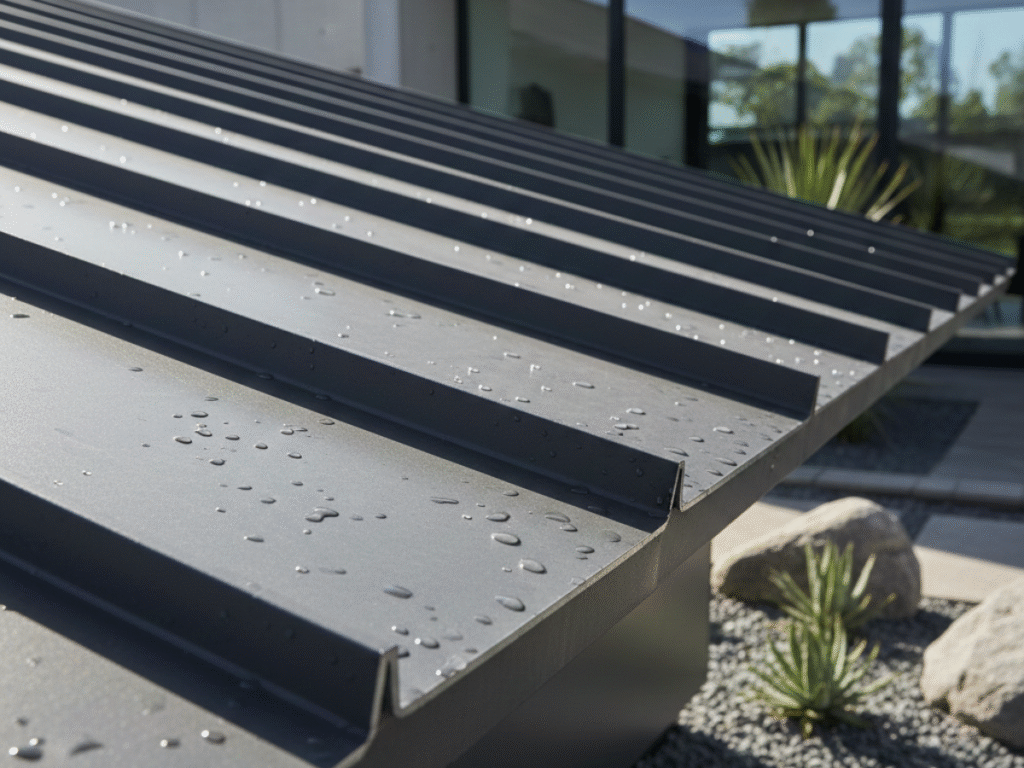Key Takeaways
- Select proper cutting tools like tin snips, circular saws, or nibblers for clean and accurate cuts.
- Secure panels on a stable work surface and use protective gear during all cutting work.
- Use metal grade blades that reduce heat and preserve panel coatings.
- Smooth edges and clear shavings to prevent corrosion.
Introduction
Metal roofing panels require precise cutting to maintain strength, clean edges, and long term performance. At The Metal Shop, accuracy is part of every fabrication step because consistent cuts help contractors achieve reliable results in the field. When handled correctly, metal roofing panels maintain their coating integrity and structural alignment through every phase of production and delivery.
Tools and Safety Gear You’ll Need
Clean, controlled cuts start with the right tools. Tin snips work for short sections, circular saws with metal rated blades handle long straight cuts, and nibblers shape curves or intricate patterns with ease.
Always wear gloves, safety glasses, and hearing protection. Metal edges can be extremely sharp during cutting, so stable handling is essential. The Metal Shop team recommends keeping panels on a secure flat surface and using clamps to reduce vibration and maintain accuracy in each cut.
How to Measure and Mark Metal Roofing Panels
Accurate measurement is the foundation of clean fabrication. Place the panel on a stable surface and mark your cutting line with a straight edge and permanent marker. Measure twice before cutting to avoid material waste.
In manufacturing environments, consistent markings across multiple panels ensure uniformity, which is crucial for contractors assembling large roofing systems.
Step by Step: Cutting Metal Roofing Panels
Using Tin Snips
Tin snips are ideal for small adjustments and detailed trimming.
- Red snips cut left curves, green snips cut right curves, and yellow snips handle straight lines.
- Keep the snips tight and move slowly so the edge stays clean.
This method works best for corners or areas too small for power tools.
Using a Circular Saw
Circular saws with carbide or fine toothed blades produce reliable straight cuts. Flip the panel so the finished coating faces downward to minimize surface marking. Move steadily and allow the blade to do the work. Excessive force creates heat that can affect the metal.
Fabricators at The Metal Shop prefer short passes and occasional pauses to prevent overheating and preserve coating quality.
Using an Angle Grinder or Nibbler
Angle grinders work quickly but create sparks, so they require controlled spacing from coated surfaces. Nibblers cut slower but offer a precise, spark free finish ideal for curved shapes and fine detailing.
Both tools are widely used in fabrication shops where custom shapes or cutouts are required before panels are shipped to contractors.
Finishing Touches and Edge Care
After the cut, smooth the edges with a fine metal file or sandpaper. This prevents burrs and protects the panel surface during transport and handling. When comparing metal roofing vs asphalt shingles, this step is especially important because metal panels require clean edges for long-term durability and proper installation. Clear all metal shavings immediately since they can rust and stain the material.
For exposed edges, apply touch up paint or a rust protective coating to preserve long term performance. At The Metal Shop, proper edge finishing is a standard part of maintaining product durability.
Common Mistakes to Avoid
Avoid these common errors that affect quality:
- Using the wrong blade, which can damage coatings.
- Cutting directly on rough surfaces like concrete, since it can scratch the finish.
- Rushing the process, which leads to heat buildup and material distortion.
- Skipping test cuts on scrap material.
Following controlled techniques ensures panels meet uniform quality standards before they leave the fabrication line.
After Cut Handling and Care
Once panels are cut, brush away all fragments and inspect the surface. Even small shavings can cause rust spots. Store extra panels in a dry, flat area to prevent bending or unwanted marks.
Metal roofing panels are engineered for longevity, and careful handling after fabrication helps preserve their expected lifespan.
Conclusion
Cutting metal roofing panels is all about precision, safety, and proper technique. With the right tools and steady control, you can produce clean, professional-grade cuts that maintain the integrity of every panel. Many homeowners ask, can you put metal roof over shingles, and when making that upgrade, accurate cutting becomes even more essential for proper installation. The Metal Shop supports contractors with high-quality materials, consistent fabrication, and dependable supply to help them achieve strong results on their projects.
FAQs
Q1. What tools work best for cutting metal roofing panels?
Tin snips, circular saws with carbide blades, and nibblers provide clean, accurate cuts suited for various shapes. We do not provide installation services.
Q2. Can an angle grinder be used to cut metal panels?
Yes, but use it with care. Angle grinders cut fast, while nibblers give a cleaner finish with no sparks. Installation is handled by your contractor.
Q3. How can I prevent rust after cutting metal roofing?
Clean off all shavings immediately and apply a rust resistant coating or touch up paint to exposed edges. We do not provide installation services.
Q4. Are these tools suitable for large scale commercial projects?
Yes, especially circular saws and nibblers, which offer speed and consistency across multiple panels. Installation is handled by your contractor.

